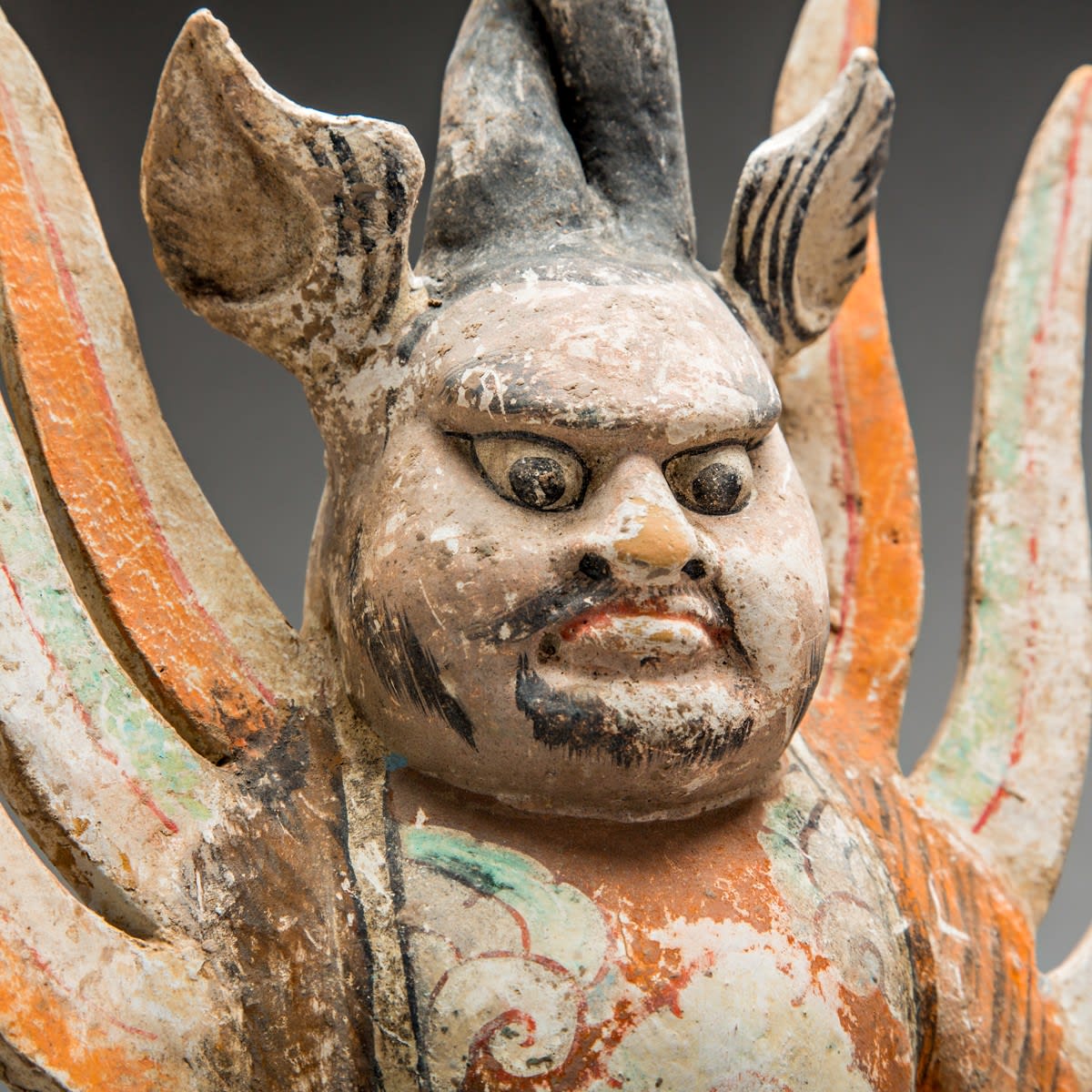Pair of Tang Sculptures of Spirit Guardians, 618 CE - 907 CE
Terracotta
37.5 x 24.1 cm
14 3/4 x 9 1/2 in
14 3/4 x 9 1/2 in
TF.008
Further images
The T’ang Dynasty was an era of unrivalled wealth and luxury. The country was successfully reunified and the borders were expanded, pushing Chinese influence into new lands. Confucianism became a...
The T’ang Dynasty was an era of unrivalled wealth and luxury. The country was successfully reunified and the borders were expanded, pushing Chinese influence into new lands. Confucianism became a semi-religious instrument of the state; yet Buddhism continued to flourish, spreading into Korea and Japan. The arts reached new levels of sophistication. Poetry and literature flourished under the enlightened rulers. The Silk Road brought fortunes into China. Precious treasures were imported on the backs of camels from far away lands and bartered for Chinese silk, medicinal herbs, and pungent spices. T’ang China was a multicultural empire where foreign merchants from across Central Asia and the Middle East settled in the urban centers, foremost among them the thriving capital of Chang’an (modern X’ian), a bustling cosmopolitan center of over two million inhabitants. Foreign traders lived next to native artisans and both thrived. New ideas and exotic artistic forms followed alongside. The T’ang Dynasty was a cultural renaissance where many of the forms and objects we now associate with China were first created. Moreover, this period represents one of the greatest cultural outpourings in human history.
As new philosophical and religious strands penetrated the thought system of early China, the subject matter of tomb objects and tomb patterns changed. The past practice of entombing elite members of society with earthenware objects continued throughout the early and middle Tang period, but the earlier emphasis placed on recreating daily life shifted to flaunting status and excess. Tombs were no longer "underground houses," but became a landscape with murals depicting the palaces, gardens, and open countryside in which the nobles passed their lives. During the Tang Dynasty, restrictions were placed on the number of objects that could be included in tombs, an amount determined by an individual's social rank. In spite of the limitations, a striking variety of tomb furnishings have been excavated. Entire retinues of ceramic figures - animals, entertainers, musicians, guardians - were buried with the dead.
The inclusion of fantastic animal guardians as part of the retinue of tomb figures began in the Northern Wei dynasty (386-534) and continued into the Tang dynasty. Also called earth spirits (dusheng), or ‘zhenmushou’ ("tomb-guarding beasts"), these guardians took the form of a fantastic hybrid creature composed of various animal and sometimes human elements and were placed in the tomb in pairs to ward off any malevolent beings who threatened to intrude. Such idea was indeed already present during the Warring States period (5th-4th centuries BC) in tombs from the southern state of Chu, where often ‘zhenmushou’ with incredible antler tines and long tongues sticking out were placed at the entrance of the tomb to guard the coffin and protect it from evil. However, in the south, tomb guardians quickly disappeared after the Eastern Jin period (317-420), an abrupt change of practice that probably reflected different cultural approaches. This was probably due to the fact that northern people -being more mindful of spirits and demons- were always more inclined to protect the dead from undesirable encounters and went into a lot of effort in creating wonderful sculptures of tomb guardians; southerners instead simply chose to continue to transmit the age-old practice of providing for the daily life of the deceased in the afterlife.
As new philosophical and religious strands penetrated the thought system of early China, the subject matter of tomb objects and tomb patterns changed. The past practice of entombing elite members of society with earthenware objects continued throughout the early and middle Tang period, but the earlier emphasis placed on recreating daily life shifted to flaunting status and excess. Tombs were no longer "underground houses," but became a landscape with murals depicting the palaces, gardens, and open countryside in which the nobles passed their lives. During the Tang Dynasty, restrictions were placed on the number of objects that could be included in tombs, an amount determined by an individual's social rank. In spite of the limitations, a striking variety of tomb furnishings have been excavated. Entire retinues of ceramic figures - animals, entertainers, musicians, guardians - were buried with the dead.
The inclusion of fantastic animal guardians as part of the retinue of tomb figures began in the Northern Wei dynasty (386-534) and continued into the Tang dynasty. Also called earth spirits (dusheng), or ‘zhenmushou’ ("tomb-guarding beasts"), these guardians took the form of a fantastic hybrid creature composed of various animal and sometimes human elements and were placed in the tomb in pairs to ward off any malevolent beings who threatened to intrude. Such idea was indeed already present during the Warring States period (5th-4th centuries BC) in tombs from the southern state of Chu, where often ‘zhenmushou’ with incredible antler tines and long tongues sticking out were placed at the entrance of the tomb to guard the coffin and protect it from evil. However, in the south, tomb guardians quickly disappeared after the Eastern Jin period (317-420), an abrupt change of practice that probably reflected different cultural approaches. This was probably due to the fact that northern people -being more mindful of spirits and demons- were always more inclined to protect the dead from undesirable encounters and went into a lot of effort in creating wonderful sculptures of tomb guardians; southerners instead simply chose to continue to transmit the age-old practice of providing for the daily life of the deceased in the afterlife.







